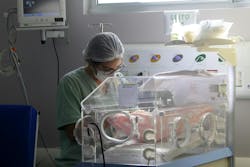In a study published in JAMA Network Open, researchers at Children’s Hospital Los Angeles found the opioid treatment that critically ill, hospitalized infants received depended on their location.
The length of time the infants were prescribed opioids differed by geographic region across the U.S.— the Northeast, South, Midwest or West. And up to 16% of this variability in infant opioid prescriptions and 20% of the methadone prescriptions—the medication used to help wean infants safely from opioids—depended on the individual hospital.
Children’s Hospital Los Angeles researchers and their collaborators conducted a retrospective study of 132,658 high-risk infants under 1 year old who were treated in 47 different children’s hospitals around the U.S. The most common high-risk diagnosis was congenital heart disease (65%), 30% of infants were born prematurely, and over half underwent surgery.
During their hospital stay, 76% of infants were prescribed opioids such as fentanyl, morphine and hydromorphone, and about 8% received methadone. But infants’ exposure to opioids and methadone post-treatment varied significantly by hospital and location.

